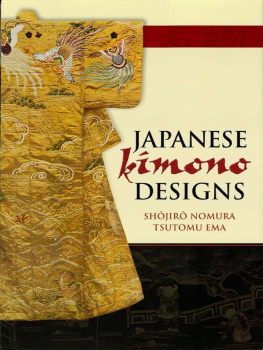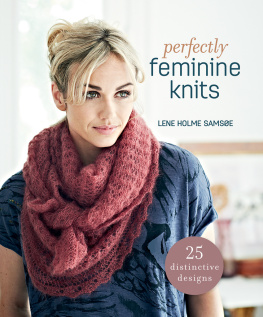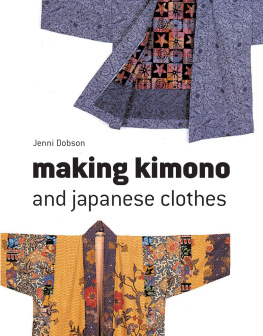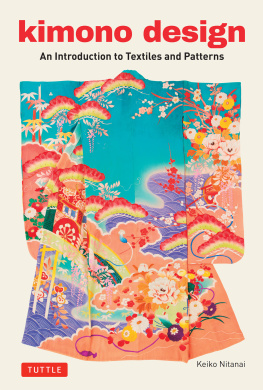KNIT KIMONO


Design Susan Wasinger
Photostyling Susan Wasinger
Illustrations Vicki Square
Photography John Mueller
Technical Editing Karen Frisa
Vicki Square
Photography Interweave Press LLC
Illustrations Vicki Square

| Interweave Press LLC 201 East 4th Street Loveland, CO 80537-5655 USA interweave.com |
Library of Congress Cataloging-in-Publication Data
Square, Vicki, 1954
Knit kimono : 18 designs with simple shapes / Vicki
Square, author.
p. cm.
Includes index.
ISBN 978-1-931499-89-7 (pbk.)
ISBN 978-1-59668-999-2 (PDF)
ISBN 978-1-62033-218-4 (ePub)
1. Knitting--Pattterns. 2. Kimonos. I. Title.
TT825.S71385 2007
746.432041--dc22
2007001891

Acknowledgments
I count it a privilege to work at what I love. Without a question, however, a project of this magnitude is a big team effort, and I am so grateful to everyone at Interweave Press who has been a part of bringing this book to fruition. Thank you Linda Ligon, founder and original visionary of Interweave Press, for giving me opportunity and letting me offer my artistic vision to kimono. Thank you to Marilyn Murphy for believing in me, to Linda Stark for all her encouragement and marketing expertise, to Tricia Waddell for her professional direction, to Paulette Livers for her hand in the art direction. My heartfelt thanks go to Ann Budd for her expert editing and oversight, her constant encouragement, and her gentle way. Thank you to Karen Frisa for excellent technical editing. Thanks go to Susan Wasinger for artistic book design and photo styling and to photographer John Mueller.
To my knitting family, I love you all and Im so grateful to have you support me so wholeheartedly, with your time, your exceptional skill, and your kind words and prayers. Lois Eynon, Joan Pickett, Micky Shafer, Sally Thieszen, Nancy Hewitt, Alice Bush, and Karen Tadich. This book would still be in the works without all of you.
To all the yarn companies who so graciously provided yarn to fulfill the vision I had for each kimono, I thank you: Berroco, Blue Sky Alpacas, Brown Sheep, Cascade, Classic Elite, Dale of Norway, Debbie Bliss, Fiesta, Louet, Mission Falls, Plymouth, Reynolds, Southwest Trading. What a joy to use so many exquisite yarns.

| Thank you to my family, who are always there to cheer me on, my husband, Johnny, son, Alexander, daughter and husband, Justine and Jeffrey. |
For Johnny, the love of my life

I have always been enchanted by the beauty and timelessness of the Japanese kimono. From casual to formal, the kimono shape has transcended time and for centuries has been a fashion cornerstone for peasantry and nobility alike. The classic rectangular, yet streamlined and elegant shape is recognized worldwide as an icon of Japanese life and culture.

As a history buff, Im fascinated by how the kimono has lasted through the ages, yet remains contemporary. The craftsmanship and precision in detail is a reflection of the structure of their society, of the beauty of organization, and of the simplicity of function.

As a knitter, Im drawn to the simple shape and construction of kimono. The rectangular pieces give me the opportunity to enjoy the peaceful meditation of knitting row after row without having to pause to think about shaping. Even the finishing involves just a few straightforward seams. If youve only knitted scarves, you can knit a kimonothink of it as a few straight scarves sewn together.
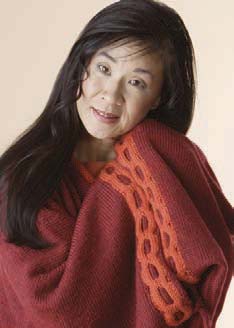
As a clothing designer, I cant help but marvel how so many simple geometric elements combine to create a garment that looks great on every imaginable body typefrom short to tall, narrow to wide, and everything in between. With the right combination of yarn, stitch pattern, and gauge, kimono offers beautiful drape and fluidity of movement thats always in style.
As an artist, Im intrigued by the way that the simple shape can become a canvas for color, pattern, and design. From just a touch of color at the edgings to a stitch or color pattern that covers the entire garment to artistic splashes of embroidery, the possibilities for design are endless.
Each kimono in this collection represents my knitted interpretation of a style or feature of traditional kimono. The styles and shapes of the garments run the gamut from short to long, rectangular sleeves to shaped, straight or overlapping front opening, with sleeves or without, casual to dressy. Ive selected yarns and stitch patterns that drape and move as beautifully as their woven counterparts. The versatility of the kimono is showcased in this collection, where youll find entirely wearable wraps from tops to jackets to light coats, all with a contemporary flair. Whether you want to follow tradition or invent your own style, you cant go wrong with a kimono.
VICKI SQUARE
The Japanese kimono is a timeless garment that is based on the simplest construction involving nothing but rectangular pieces of cloth. From simple work clothes to elegant formal attire for nobility, the kimono runs the gamut from subdued and practical to flamboyant and ostentatious. Add to this versatility the fact that a kimono looks good on any body typefrom huge sumo wrestler to petite geishaand youve quite possibly got the ideal garment.
The kimono shape is certainly ideal for knitters. Even beginning knitters who havent ventured beyond simple scarves can be ensured success with the first attempt. Think of the kimono as five large rectangular scarvesone for the back, one for each half of the front, and one for each sleeve. The only difference is that the rectangles are sewn (or in some cases, knitted) together. Experienced knitters can hone their skills by working intricate color or stitch patterns or by adding fine embellishments. Whatever your knitting expertise and whatever your shape, youll find a knitted kimono a classic and sophisticated alternative to the traditional Western cardigan or jacket.





